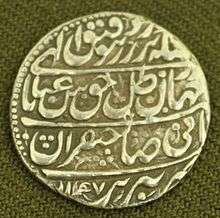Abbas III
| Shah Abbas III | |
|---|---|
| Shahanshah of Persia, Sahib-i-Qiran, Sultan bar Salatin [1] | |
 | |
| Reign | 1732–1736 |
| Coronation | 7 September 1732 |
| Predecessor | Tahmasp II |
| Successor | Nader Shah |
| Born | January 1732 |
| Died |
February 1740 Sabzevar |
| House | Safavi |
| Father | Tahmasp II |
Abbas III (January 1732 – February 1740) (Persian: شاه عباس سوم) reigned 1732–1736; was a son of Shah Tahmasp II and Shahpuri Begum of the Safavid dynasty. After the deposition of his father by Nader Khan (the future Nader Shah) the infant Abbas was appointed nominal ruler of Iran on 7 September 1732.[2] Nader Khan, who was the real ruler of the country, assumed the positions of deputy of state and viceroy. Abbas III was deposed in March 1736, when Nader Khan had himself crowned as Nader Shah. This marked the official end of the Safavid dynasty. Abbas was sent to join his father in prison in Sabzevar, Khorasan.[3]
In 1738, Nader Shah set out on campaign to Afghanistan and India, leaving his son Reza Qoli Mirza to rule his realm in his absence. Hearing rumours that his father had died, Reza made preparations for assuming the crown. According to the most "authoritative account",[4] Mohammed Hosein Khan Qajar, who had been entrusted with supervising Abbas and his father in captivity, warned Reza that the townspeople of Sabzevar would rise up in revolt, free Tahmasp II and place him on the throne again on hearing the news of Nader's death. Reza gave Mohammed Hosein orders to execute Tahmasp and his sons to forestall this. Mohammed Hosein strangled Tahmasp, cut the young Abbas down with his sword and had his brother Esmail killed too. According to Michael Axworthy, the dating of these events is speculative, but they probably took place in May or June 1739.[5] Other sources (Encyclopaedia Iranica, Lockhart) prefer 1740.
References
Bibliography
- Michael Axworthy Sword of Persia: Nader Shah: From Tribal Warlord to Conquering Tyrant (IB Tauris, 2006)
- L. Lockhart, Nadir Shah, London, 1938
- R.M. Savory, Encyclopaedia Iranica
| Preceded by Tahmasp II |
Shah of Persia 1732–1736 |
Succeeded by Nadir Shah Afshar |
| Preceded by Tahmasp II |
Head of Safavid Dynasty 1732–1736 |
Succeeded by Suleiman II of Persia (Pretender) |